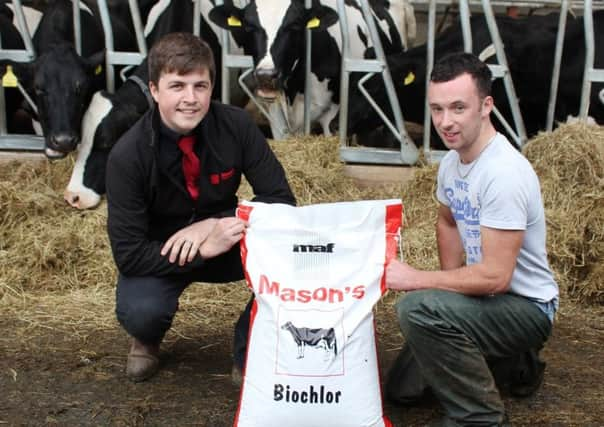Biochlor approach to dry cow nutrition pays dividends


“Our calving index is currently in the region of 380 days,” Chris explained.
“All cows are bred to AI bulls. Improving fertility levels is an important priority for the business. But so is getting our dry cow management right.
Advertisement
Advertisement
“We want the cows to calve down easily, come back into milk quickly and have calves that are bright, full of life and straightforward to rear.”
The Gordons make a bespoke forage for their dry cows. It comprises baled silage, which is wrapped at a dry matter content in excess of 50%.
“The sward receives no slurry at all, which means that Potash levels are kept as low as possible,” Chris explained.
He continued: “We give all the cows a two-month dry period. At drying-off they are drenched for worms and liver fluke. We also pare the cows’ feet at that stage.
Advertisement
Advertisement
“At this time of the year, the cows are then put out to grass. Three weeks prior to calving, they are housed and put on the baled silage. At this stage they are also offered four kilos per day of the Biochlor, pre calving ration from Mason’s Animal Feeds. They are maintained on this diet right through to calving.”
Michael confirmed that the Biochlor diet has been offered to the pre-calving cows in the herd for the past two years.
“Prior to that we had been having some problems with retained cleanings. However, since moving to the Biochlor diets, this has not been a problem.”
Mason’s Michael Stewart was a recent visitor to the Gordon farm.
Advertisement
Advertisement
“The Biochlor ration is manufactured specifically by the company,” he said.
“It has a proven track record in allowing dairy cows to calve down without problems. As a result they are ready to produce milk in the most efficient and effective way possible throughout their subsequent lactations.”
Michael added: “Biochlor works by enhancing the bacterial and other microbial populations in the cow’s rumen.
“The theory is very simple: by identifying the factors limiting bacterial growth in the rumen, it is feasible to improve the feed conversion levels obtained by the cows in the run-up to calving.”
Advertisement
Advertisement
Michael confirmed that the Biochlor ration is fed at a rate of 4 kilos per day during the three weeks leading up to calving, adding:
“It is offered with grass silage or, if available, 50% whole crop and 50% grass silage plus straw to appetite.
“Freshly calved cows and heifers reach peak yields much more quickly.
“These are sustained longer, resulting in greater overall lactation yield compared to those not receiving the Biochlor ration.
Advertisement
Advertisement
“In addition to improved milk yields overall herd health is significantly improved, with much fewer displaced abomasums, milk fevers and retained placentas plus significantly improved fertility reported by those herdowners using the Biochlor approach to dry cow management.”
For further information, contact Mason’s Animal Feeds on (028) 3887 1500